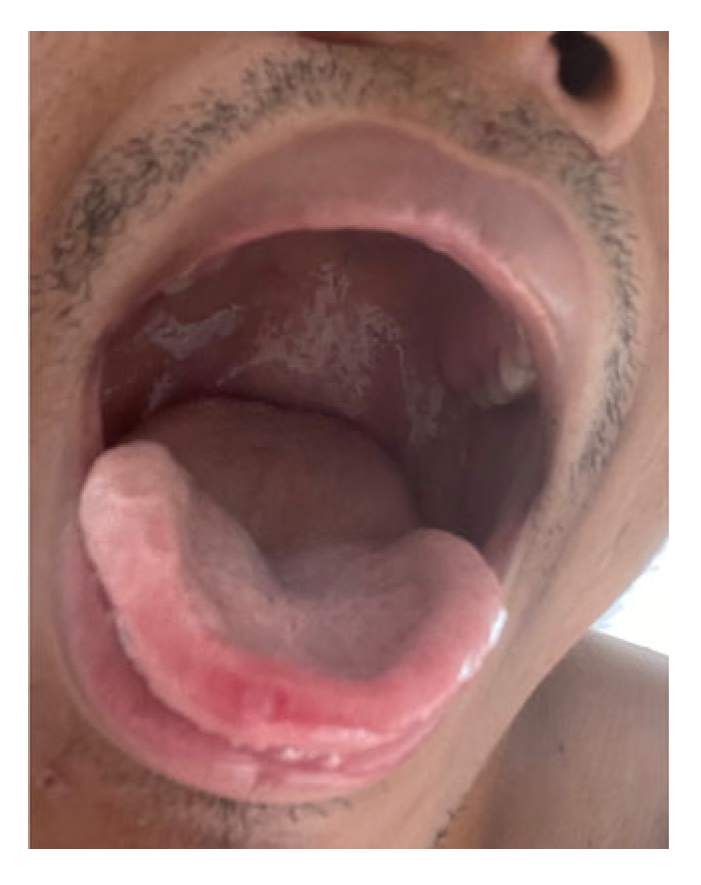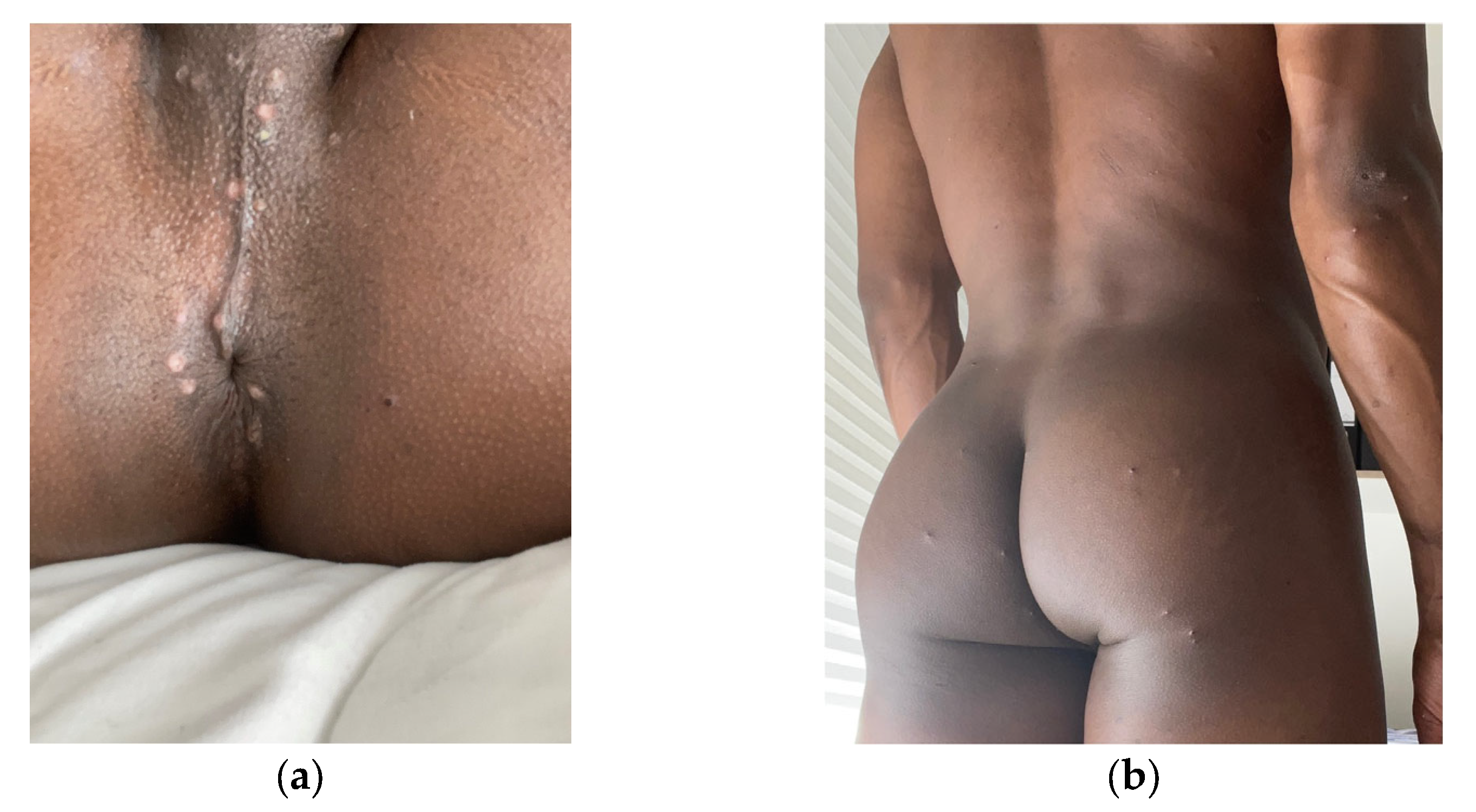Monkeypox in a Patient with Controlled HIV Infection Initially Presenting with Fever, Painful Pharyngitis, and Tonsillitis
Abstract
1. Background
2. Case Presentation
2.1. Recent Medical History
2.2. Presentation
2.3. Clinical Course
2.4. Outcomes

3. Discussion
4. Conclusions
Author Contributions
Funding
Institutional Review Board Statement
Informed Consent Statement
Data Availability Statement
Acknowledgments
Conflicts of Interest
Abbreviations
References
- Thornhill, J.P.; Barkati, S.; Walmsley, S.; Rockstroh, J.; Antinori, A.; Harrison, L.B.; Palich, R.; Nori, A.; Reeves, I.; Habibi, M.S.; et al. Monkeypox Virus Infection in Humans across 16 Countries—April-June 2022. N. Engl. J. Med. 2022, 8, 679–691. [Google Scholar] [CrossRef]
- Isidro, J.; Borges, V.; Pinto, M.; Sobral, D.; Santos, J.D.; Nunes, A.; Mixao, V.; Ferreira, R.; Santos, D.; Duarte, S.; et al. Phylogenomic characterization and signs of microevolution in the 2022 multi-country outbreak of monkeypox virus. Nat. Med. 2022, 28, 1569–1572. [Google Scholar] [CrossRef] [PubMed]
- McCollum, A.M.; Damon, I.K. Human monkeypox. Clin. Infect. Dis. 2014, 58, 260–267. [Google Scholar] [CrossRef] [PubMed]
- Yinka-Ogunleye, A.; Aruna, O.; Dalhat, M.; Ogoina, D.; McCollum, A.; Disu, Y.; Mamadu, I.; Akinpelu, A.; Ahmad, A.; Burga, J.; et al. Outbreak of human monkeypox in Nigeria in 2017-18: A clinical and epidemiological report. Lancet Infect. Dis. 2019, 19, 872–879. [Google Scholar] [CrossRef]
- Vaughan, A.; Aarons, E.; Astbury, J.; Brooks, T.; Chand, M.; Flegg, P.; Hardman, A.; Harper, N.; Jarvis, R.; Mawdsley, S.; et al. Human-to-Human Transmission of Monkeypox Virus, United Kingdom, October 2018. Emerg. Infect. Dis. 2020, 26, 782–785. [Google Scholar] [CrossRef] [PubMed]
- Monkeypox. World Health Organization, 19 May 2022. Available online: https://www.who.int/news-room/fact-sheets/detail/monkeypox (accessed on 31 August 2022).
- Ligon, B.L. Monkeypox: A review of the history and emergence in the Western hemisphere. Semin. Pediatr. Infect. Dis. 2004, 15, 280–287. [Google Scholar] [CrossRef] [PubMed]
- Sah, R.; Abdelaal, A.; Reda, A.; Katamesh, B.E.; Manirambona, E.; Abdelmonem, H.; Mehta, R.; Rabaan, A.A.; Alhumaid, S.; Alfouzan, W.A.; et al. Monkeypox and Its Possible Sexual Transmission: Where Are We Now with Its Evidence? Pathogens 2022, 11, 924. [Google Scholar] [CrossRef] [PubMed]
- Bragazzi, N.L.; Kong, J.D.; Mahroum, N.; Tsigalou, C.; Khamisy-Farah, R.; Converti, M.; Wu, J. Epidemiological trends and clinical features of the ongoing monkeypox epidemic: A preliminary pooled data analysis and literature review. J. Med. Virol. 2022, 1–8. [Google Scholar] [CrossRef] [PubMed]
- Antinori, A.; Mazzotta, V.; Vita, S.; Carletti, F.; Tacconi, D.; Lapini, L.E.; D’Abramo, A.; Cicalini, S.; Lapa, D.; Pittalis, S.; et al. Epidemiological, clinical and virological characteristics of four cases of monkeypox support transmission through sexual contact, Italy, May 2022. Euro Surveill 2022, 27, 2200421. [Google Scholar] [CrossRef] [PubMed]
- Joint ECDC-WHO Regional Office for Europe Monkeypox Surveillance Bulletin, 29 June 2022. Available online: https://cdn.who.int/media/docs/librariesprovider2/monkeypox/monkeypox_euro_ecdc_final_jointreport_2022-06-29_edited.pdf (accessed on 31 August 2022).
- Khanna, U.; Kost, Y.; Wu, B. Diagnostic Considerations in Suspected Cases of Monkeypox. J. Am. Acad. Dermatol. 2022. [Google Scholar] [CrossRef] [PubMed]
- EMA: Tecovirimat Siga. Available online: https://www.ema.europa.eu/en/medicines/human/EPAR/tecovirimat-siga (accessed on 31 August 2022).
- Grosenbach, D.W.; Honeychurch, K.; Rose, E.A.; Chinsangaram, J.; Frimm, A.; Maiti, B.; Lovejoy, C.; Meara, I.; Long, P.; Hruby, D.E. Oral Tecovirimat for the Treatment of Smallpox. N. Engl. J. Med. 2018, 379, 44–53. [Google Scholar] [CrossRef]
- Adler, H.; Gould, S.; Hine, P.; Snell, L.B.; Wong, W.; Houlihan, C.F.; Osborne, J.C.; Rampling, T.; Beadsworth, M.B.; Duncan, C.J.; et al. Clinical features and management of human monkeypox: A retrospective observational study in the UK. Lancet Infect. Dis. 2022, 22, 1153–1162. [Google Scholar] [CrossRef]
- CDC: Considerations for Monkeypox Vaccination. Available online: https://www.cdc.gov/poxvirus/monkeypox/considerations-for-monkeypox-vaccination.html (accessed on 31 August 2022).
- 2022 Monkeypox Outbreak Global Map. Available online: https://www.cdc.gov/poxvirus/monkeypox/response/2022/world-map.html (accessed on 31 August 2022).
- WHO Director-General Declares the Ongoing Monkeypox Outbreak a Public Health Emergency of International Concern. Available online: https://www.who.int/europe/news/item/23-07-2022-who-director-general-declares-the-ongoing-monkeypox-outbreak-a-public-health-event-of-international-concern (accessed on 31 August 2022).
- Perez Duque, M.; Ribeiro, S.; Martins, J.V.; Casaca, P.; Leite, P.P.; Tavares, M.; Mansinho, K.; Duque, L.M.; Fernandes, C.; Cordeiro, R.; et al. Ongoing monkeypox virus outbreak, Portugal, 29 April to 23 May 2022. Euro Surveill 2022, 27, 2200424. [Google Scholar] [CrossRef] [PubMed]
- Inigo Martinez, J.; Gil Montalban, E.; Jimenez Bueno, S.; Martin Martinez, F.; Nieto Julia, A.; Sanchez Diaz, J.; Garcia Marin, N.; Cordoba Deorador, E.; Nunziata Forte, A.; Alonso Garcia, M.; et al. Monkeypox outbreak predominantly affecting men who have sex with men, Madrid, Spain, 26 April to 16 June 2022. Euro Surveill 2022, 27, 2200471. [Google Scholar] [CrossRef]
- WHO: Vaccines and Immunization for Monkeypox: Interim Guidance, 14 June 2022. Available online: https://www.who.int/publications/i/item/WHO-MPX-Immunization-2022.2-eng (accessed on 31 August 2022).
- EMA: Imvanex. Available online: https://www.ema.europa.eu/en/medicines/human/EPAR/imvanex (accessed on 31 August 2022).
- Robert-Koch-Institut: Epidemiologisches Bulletin 25/26 2022. Available online: https://www.rki.de/DE/Content/Infekt/EpidBull/Archiv/2022/Ausgaben/25-26_22.pdf?__blob=publicationFile (accessed on 31 August 2022).


Publisher’s Note: MDPI stays neutral with regard to jurisdictional claims in published maps and institutional affiliations. |
© 2022 by the authors. Licensee MDPI, Basel, Switzerland. This article is an open access article distributed under the terms and conditions of the Creative Commons Attribution (CC BY) license (https://creativecommons.org/licenses/by/4.0/).
Share and Cite
Fischer, F.; Mehrl, A.; Kandulski, M.; Schlosser, S.; Müller, M.; Schmid, S. Monkeypox in a Patient with Controlled HIV Infection Initially Presenting with Fever, Painful Pharyngitis, and Tonsillitis. Medicina 2022, 58, 1409. https://doi.org/10.3390/medicina58101409
Fischer F, Mehrl A, Kandulski M, Schlosser S, Müller M, Schmid S. Monkeypox in a Patient with Controlled HIV Infection Initially Presenting with Fever, Painful Pharyngitis, and Tonsillitis. Medicina. 2022; 58(10):1409. https://doi.org/10.3390/medicina58101409
Chicago/Turabian StyleFischer, Fabian, Alexander Mehrl, Melanie Kandulski, Sophie Schlosser, Martina Müller, and Stephan Schmid. 2022. "Monkeypox in a Patient with Controlled HIV Infection Initially Presenting with Fever, Painful Pharyngitis, and Tonsillitis" Medicina 58, no. 10: 1409. https://doi.org/10.3390/medicina58101409
APA StyleFischer, F., Mehrl, A., Kandulski, M., Schlosser, S., Müller, M., & Schmid, S. (2022). Monkeypox in a Patient with Controlled HIV Infection Initially Presenting with Fever, Painful Pharyngitis, and Tonsillitis. Medicina, 58(10), 1409. https://doi.org/10.3390/medicina58101409





